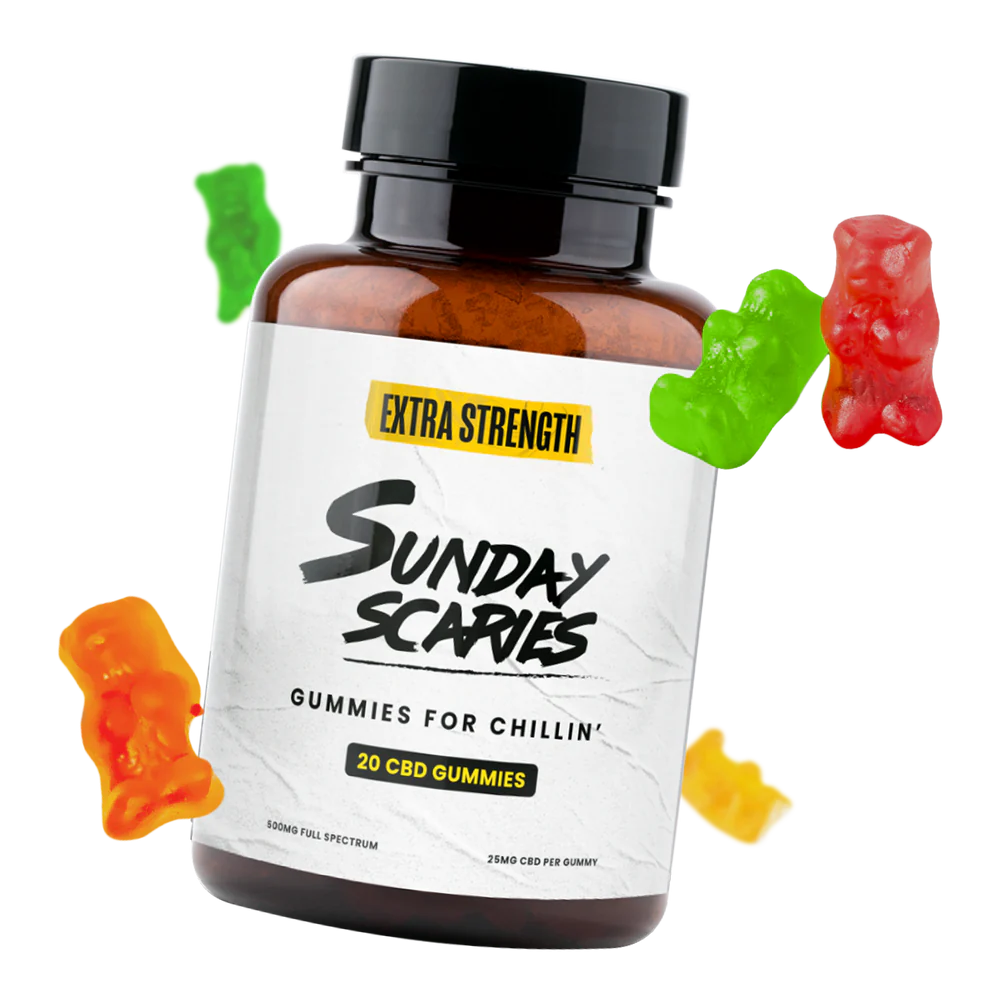The cannabis plant has a long history of being used for various purposes including its potential therapeutic properties. Cannabis consists of many substances, which are divided into two categories: cannabinoids and non-cannabinoids. One of the two most well-known cannabinoids is THC But what does THC stand for? It’s an abbreviation for delta 9 tetrahydrocannabinol. This substance is an active ingredient found in many marijuana, hemp, and cannabis products.
Delta 9 tetrahydrocannabinol is the primary psychoactive substance found in marijuana, and it’s responsible for the “high” feeling. In addition to producing mind-altering effects, research suggests THC may have healing properties that make it a useful tool in the treatment of various symptoms and conditions.
In this post, we’ll delve into the potential uses and effects of this potent cannabinoid. We’ll talk about different types of marijuana, cannabis, and hemp products and how they interact with the brain and body. We’ll explore how THC may be medically beneficial and the possible side effects and risks associated with its use. Plus, we’ll examine the legality of THC, its detectability by drug screens, and the similarities and differences between THC and CBD. Keep reading to learn more about tetrahydrocannabinol, more commonly known as THC!
Overview of THC
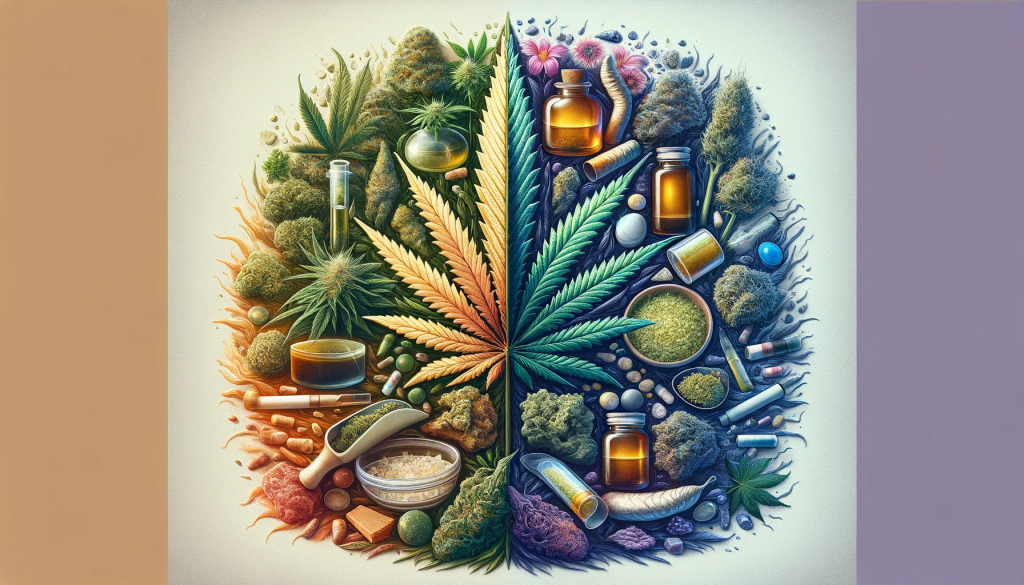
Tetrahydrocannabinol/THC is the primary psychoactive compound in the cannabis plant. It’s a naturally occurring crystalline alkaloid found in various strains of marijuana. THC is considered a drug and is what gives hemp products their mind-altering capabilities. It’s often used recreationally but can also be for the treatment of some medical conditions.
THC acts on CB1 and CB2 cannabinoid receptors throughout the brain and body. The interaction between CB1 receptors and THC results in a variety of psychoactive effects that make THC popular for recreational use.
Cannabis-derived THC and hemp products come in many forms and can be used in a variety of ways. Smoking, vaping, and oral administration via tinctures are some of the fastest ways to feel the effects of THC.
When used for medicinal purposes, THC may help to curb nausea and treat pain. This makes it particularly beneficial for those living with cancer or AIDS. While there are potential benefits of using marijuana, there are also some possible risks and side effects to consider.
THC tends to stay in the system longer than most other drugs, making it highly detectable during drug screenings. While it’s not approved by the FDA, THC is considered a legal drug in many states. THC shares some similarities, as well as many notable differences, with CBD—one of the other main cannabinoids found in cannabis. These components each have their own unique properties and effects, and they can be used individually or in combination with one another to treat nausea, pain, and other symptoms of various health conditions.
More research is needed on THC and other cannabinoids, however, present research and studies suggest there are many potential benefits of using cannabis for therapeutic purposes.
Interactions With the Body
Metabolization of THC
After THC is taken, it’s absorbed into the bloodstream and reaches peak concentration levels after 60 to 90 minutes. THC then makes its way to tissues and organs including the brain, heart, and kidneys. The metabolization process begins in the liver where metabolites, including THC COOH, are produced. THC and its metabolites are ultimately eliminated from the body through urine, feces, and sweat. During the final metabolic stage, THC COOH and other metabolites travel to the intestines via bile and are broken down by bacteria before they’re excreted in feces. Approximately 65% of THC is eliminated through feces, 20% is eliminated through urine, and 15% is eliminated through sweat.
The Endocannabinoid System
The endocannabinoid system consists of endocannabinoids, also known as endogenous cannabinoids, which are lipid-based neurotransmitters that bind to receptors. When THC is inhaled or consumed, it interacts with endocannabinoid receptors located in the brain and throughout the body. These cannabinoid receptors control a range of mental and physical functions including memory processing, appetite regulation, energy metabolism, and pain perception.
Most of the effects produced by THC result from its connections with CB1 and CB2 receptors. The bond between THC and CB1 receptors produces psychotropic effects, which can include altered perception of time and senses and euphoria. When THC binds with CB2 receptors, the results are anti-inflammatory and immunosuppressant properties.
Products Containing THC
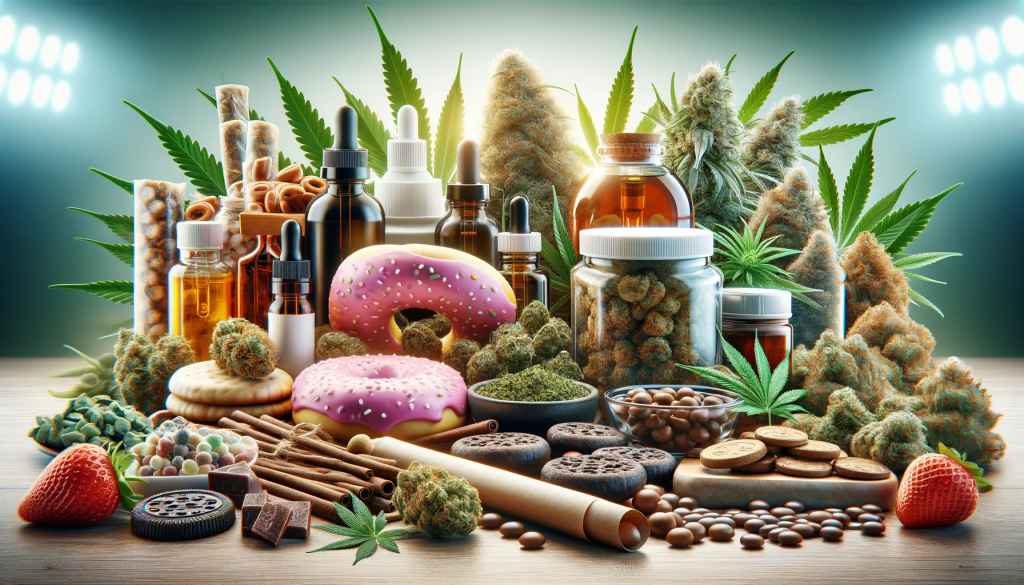
According to the National Survey on Drug Use and Health, cannabis is one of the most commonly used drugs in the United States. Cannabis products are available in many forms, the most popular of which are tinctures, flower, vapes, edibles, and topicals.
Tinctures
These herbal solutions result from steeping cannabis in alcohol. They’re typically taken via oral administration (placed under the tongue). As a result, they absorb quickly into the blood vessels, providing a fast onset of effects.
Flower
Flower is one of the most affordable THC-containing products. It can be smoked in a bowl, joint, pipe, or bong, and it’s available in various strains.
Vapes
Like flower, THC vapes and delta carts are meant to be inhaled. These products are gentler on the lungs and come in a variety of flavors. They’re small, discreet, and a great alternative for those who don’t care for the robust scent of cannabis.
Edibles
Oral THC, or edibles, include capsules, brownies, gummies, baked goods, teas, and any other edible or drinkable product that’s infused with THC. These can take a bit longer to kick in than other products containing THC.
Topicals
These products are infused with THC and applied to the skin. They typically don’t produce mind-altering effects, and they can include balms, lotions, ointments, sprays, salves, and transdermal patches.
Medical Uses of THC
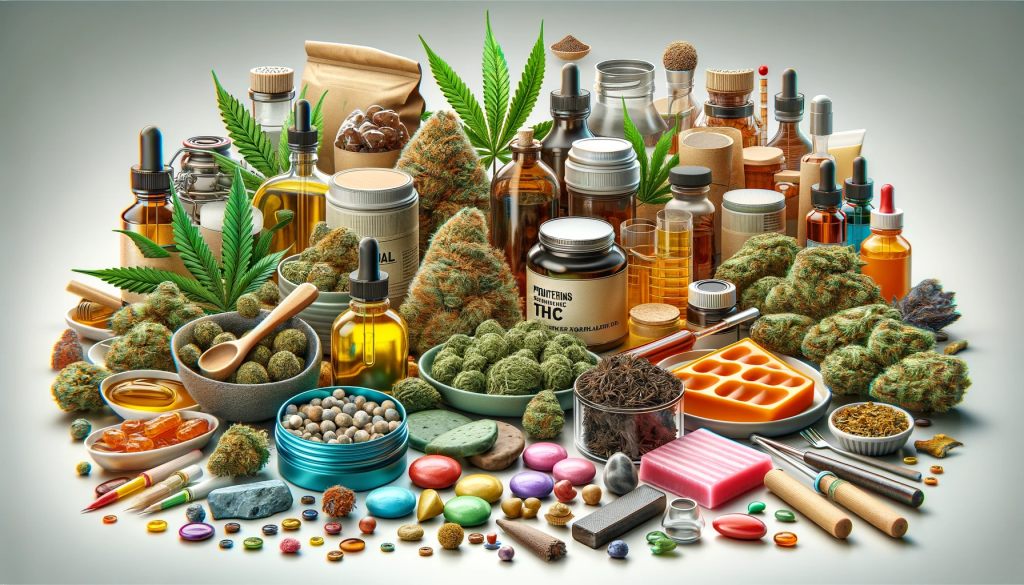
Research indicates THC has potential medicinal applications, such as relieving symptoms of chronic conditions like Crohn’s disease and certain forms of epilepsy.
Potential Relief From Symptoms of Chronic Conditions
THC is a chemical compound found in the cannabis plant and is responsible for its psychoactive effects. The medical use of THC can offer potential relief from symptoms of various conditions such as chronic pain, nausea, and poor appetite.
THC interacts with cannabinoid receptors in the endocannabinoid system to stimulate various responses functioned by anandamide: an endogenous ligand that helps to regulate processes like pain sensations and inflammation.
Research indicates that cannabis and cannabinoids may be effective at treating chronic pain due to their ability to interact with the brain and central nervous system and produce anti-inflammatory properties through non-opioid pathways.
Medical marijuana can stimulate the appetite, reduce nausea, and prevent weight loss, making it potentially beneficial for those who are undergoing chemotherapy or living with AIDS.
Potential Risks Associated with THC
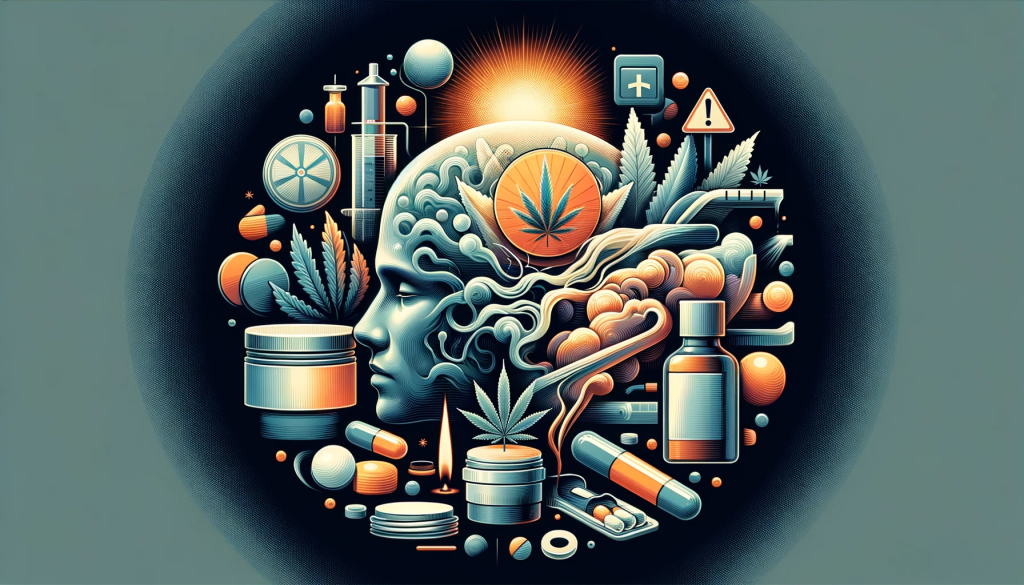
Possible Side Effects of THC
While there’s growing evidence and promising research in favor of THC’s potential therapeutic benefits, it’s important to be aware of the possible side effects of THC use, which include the following:
- Mood changes
- Impaired motor functions
- Difficulty with problem-solving skills
- Altered perception of time
- Sensory alterations
- Memory impairment
- Temporary increase in heart rate
- Mild anxiety
The following side effects may present as a result of overuse, misuse, or use of high doses of tetrahydrocannabinol/THC:
- Extreme anxiety or panic
- Delusions
- Hallucinations
- Psychosis
In summary, the potential side effects associated with marijuana or cannabis use can range from minor changes in mood or memory to more severe effects such as psychosis. The type and intensity of these effects are influenced by many factors including strain, potency, frequency of use, tolerance level, and duration of use.
Possible Interactions with Other Substances
Hemp products can have interactions with over-the-counter medicine, prescribed medicine, and other substances. Because of this, it’s important to consult your doctor before using hemp-derived products, especially if you’re taking any prescription or non-prescription medications or dietary supplements.
Potential for Abuse and Addiction
As the main psychoactive element found in cannabis, tetrahydrocannabinol/THC has a wide range of uses. Although medical cannabis can be used to treat certain chronic physical conditions or symptoms such as pain, nausea, or lack of appetite, THC is often used for recreational purposes and poses a potential for misuse and addiction.
Research and evidence from some studies suggest early exposure to cannabinoids, including THC, can increase the chances of developing other substance use disorders later on. Underlying mental health issues like anxiety and depression may make individuals vulnerable to misusing marijuana medicinally as well. When taken beyond its intended purpose, it can increase the risk of developing a substance abuse disorder.
While this can occur with smoking marijuana flower, vaping THC-containing products has also been linked with negative effects and potential for abuse and addiction.
Potential for Toxicity
The use of THC in medical applications has the potential for toxicity, particularly when used in high doses and frequency. Consuming marijuana through edibles poses a greater risk due to the difficulty of controlling dose size and ingestion rate. Additionally, the effects of THC take longer to kick in with edibles than with other types of products, leading many people to take more of the edibles than recommended.
Ingesting large amounts can lead to adverse symptoms such as dizziness, nausea, incoordination, euphoria, seizures, vision issues, and anxiety. Furthermore, using marijuana with higher-than-necessary levels of THC may result in physical damage to organs like the liver or kidneys.
There’s also a potential for dependency on cannabinoid compounds found in products containing THC, and overexposure can result in unpleasant withdrawal symptoms, which may require medical assistance to alleviate.
Drug Test Detectability
Drug screening to test for cannabis use is commonplace, so it’s important to be aware of different testing methods and how long THC can remain detectable. As mentioned earlier, THC tends to linger in the body longer than CBD and other cannabinoids. Part of the reason for this is that THC is highly lipophilic. Because of its high lipid solubility, THC accumulates in the body’s fat cells and is released slowly over time, so it remains present and detectable in the body for extended periods.
The most common detection methods used to test for cannabis are urine analysis, blood tests, hair tests, and saliva tests. THC can remain detectable in urine for between 48 hours and 30 days, depending on potency and frequency of use. Blood tests are far less sensitive and can usually only detect THC for a few hours after use. THC and THC COOH can remain in the hair for up to a year, giving hair tests the longest detection window of all testing methods. Lastly, saliva tests can be used to detect THC for up to 72 hours after use.
Differences Between THC and CBD
THC and CBD are both cannabinoids, but they have vastly different effects on the brain and body, as well as differences in legal status.
Chemical Structure
THC, or delta 9 tetrahydrocannabinol, is a cannabinoid chemical with a basic structure of 21 carbon atoms and 30 hydrogen atoms. CBD shares the same basic structure, however. THC differs from its close relative CBD in that it has an extra six-membered ring formed by the attachment of a carbon molecule and an oxygen molecule.
This molecular difference results in very different effects on humans and animals when comparing THC and CBD products, making them distinct from one another within the realm of cannabis extract products.
At the molecular level, THC activates specific receptors in our bodies’ endocannabinoid system, and its psychoactive properties cause changes in perception, mood, appetite, and other physiological processes.
In comparison to this marijuana-derived compound, CBD doesn’t activate these same receptors or create any significant psychoactive effect; this allows for potential medical use without many of the side effects related to THC consumption.
Effects on the Body
THC, the main psychoactive compound in cannabis, has different effects on the body compared to other cannabinoids like CBD. While THC and CBD both demonstrate anti-inflammatory and pain-relieving properties, only THC produces mind-altering effects in humans and animals. THC and CBD products share the potential to alleviate symptoms of multiple sclerosis, cancer, and epilepsy, however, CBD shows better potential for alleviating anxiety and anxiety-related symptoms.
While THC and CBD can both produce side effects such as fatigue and dry mouth, the possible side effects of CBD are fewer and significantly milder than those of THC. CBD can cause a reduction in appetite, temporary hypotension, drowsiness, and lightheadedness, whereas THC can cause more intense side effects—such as delayed reaction times, altered perception, paranoia, anxiety, delusions, and hallucinations—especially with overuse or potent doses.
Legality
Federally, THC and CBD products are considered legal. However, given THC’s psychotropic properties, it’s subject to stricter laws and regulations than CBD. THC is considered a Schedule I drug. These types of drugs have the potential to be abused and have no recognized medical applications.
CBD, on the other hand, is illegal on a federal level if it’s derived from marijuana. However, if it’s derived from hemp, CBD is federally legal.
State laws regarding the use of cannabis can and often do conflict with federal law. The legality of THC varies from state to state with many states allowing the use of medical marijuana and/or recreational THC use and some states prohibiting cannabis altogether. For instance, recreational marijuana is now legal in 13 states and decriminalized in 15 others. However, the sale of medical cannabis products, such as those containing THC, is still illegal under federal law.
With laws surrounding cannabis often changing and conflicting, it’s important to be aware of the local laws in your area and those in any areas you may be visiting or traveling to. By staying abreast of federal and state laws, you’ll be well-informed and better able to ensure that you don’t unknowingly commit a crime.
Other Forms of THC to Explore
FAQ
How does medical cannabis differ from non-medical cannabis?
Medical cannabis typically has a lower concentration of THC than recreational cannabis. As a result, medical marijuana generally produces less mind-altering effects than recreational marijuana.
Does THC have any medical benefits?
Yes, peer-reviewed studies suggest that medical marijuana may be able to help treat symptoms associated with certain medical conditions such as pain, inflammation, and nausea.
What are delta 9 and delta 8 THC?
Delta 9 tetrahydrocannabinol is a type of cannabis that’s named for having nine THC molecules. It’s a psychotropic drug and, unlike CBD, it produces mind-altering effects. Delta 8 THC, on the other hand, is a bit milder than Delta 9, and produces fewer side effects.
Is THC federally legal?
THC is illegal on a federal level. As is the case for other Schedule I controlled substances, possession, sale, or use of THC products can result in criminal prosecution by the Drug Enforcement Administration.
Does cannabis contain other cannabinoids?
Yes! THC and CBD are only two types of cannabinoids found in cannabis plants. According to the National Center for Complementary and Integrative Health, the cannabis plant contains 100 known cannabinoids and 300 non-cannabinoid substances in addition to THC and CBD.
Is synthetic THC safe?
While THC is naturally found in cannabis, some types of THC are created via synthesis. Two of the most well-known names for synthetic cannabinoid agonists are “Spice” and “K2.” These drugs mimic THC and can have harmful—or in some cases, fatal—health effects. Given its unpredictable and severe effects, it’s advisable to avoid using THC or cannabinoids that are created via synthesis.
Are there different types of cannabis plants?
Yes, there are different types of cannabis plants, and each kind has its own unique effects. For example, products made from the cannabis sativa plant are known for boosting energy levels and improving mood, making them a great choice for daytime use. On the other hand, products made from the cannabis indica plant tend to have relaxing and calming effects, making them better suited for nighttime use.
Are THC and CBD FDA-approved?
At this time, THC and CBD aren’t approved by the FDA. Hemp products can’t be legally sold across state lines as food additives or dietary supplements. However, THC and CBD products may be legal in some states, depending on local legislation.
Conclusion
THC is the primary psychoactive component of the cannabis indica and cannabis sativa plant, primarily responsible for the mind-altering effects experienced by marijuana users. It’s present in a wide range of marijuana products—from vapes and edibles to topicals and tinctures—and many studies suggest it may be helpful in the treatment of various health conditions. THC has the potential to alleviate pain, boost appetite, and minimize nausea.
The use of THC can also come with risks and dangers, especially if it’s misused or abused. THC is psychotropic and has the potential to be addictive. Overuse of THC can lead to the development of substance abuse disorders.
THC lingers for a long time, making it highly detectable by drug screening methods such as urine, hair, blood, and saliva tests. Although laws regarding THC are constantly changing, at this time, THC is federally illegal and isn’t approved by the FDA. However, the use of THC medically and/or recreationally may be permitted in some states.
The chemical structure and effects of THC are very different from CBD, another cannabinoid molecule found in cannabis plants. Unlike THC, CBD doesn’t have any psychoactive effects. Research into potential therapeutic usage of both THC and CBD is ongoing, however, both show medical promise.




